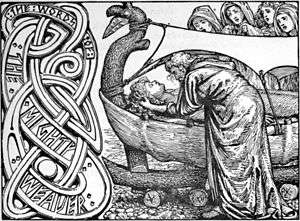Death or departure of the gods

Odin's last words to Baldr (1908) by W.G. Collingwood (1854–1932)
A dying god, or departure of the gods is a motif in mythology where a god or an entire pantheon dies or is killed or destroyed.
Frequently cited examples of dying gods are Balder in Norse mythology, or Quetzalcoatl in Aztec mythology. A special subcategory is the death of an entire pantheon, the most notable example being Ragnarök in Norse mythology, with other examples from Ireland, India, Hawaii and Tahiti.[1]
"Death or departure of the gods" is motif A192 in Stith Thompson's Motif-Index of Folk-Literature, with the following subcategories:[1]
- A192.1. Death of the gods (also F259.1. Mortality of fairies)
- A192.1.1. Old god slain by young god. (also A525.2. Culture hero (god) slays his grandfather)
- A192.1.2. God killed and eaten
- A192.2. Departure of gods (also A560. Culture hero's (demi-god's) departure)
- A192.2.1. Deity departs for heaven (skies).
- A192.2.1.1. Deity departs for moon.
- A192.2.2. Divinity departs in boat over sea.
- A192.2.3. Divinity departs to submarine home.
- A192.2.4. Divinity departs in column of flame.
- A192.2.1. Deity departs for heaven (skies).
- A192.3. Expected return of deity.
- A192.4. Divinity becomes mortal.
A separate (although related and overlapping) category are gods who die and are also resurrected (Thompson's motif A193), see Dying-and-rising god.
See also
References
- Burkert, Walter 1979. Structure and History in Greek Mythology and Ritual. London: University of California Press.
- Leeming, David. "Dying god". The Oxford Companion to World mythology. Oxford University Press, 2004. Oxford Reference Online. Oxford University Press. UC - Irvine. 5 June 2011 <http://www.oxfordreference.com/views/ENTRY.html?subview=Main&entry=t208.e469>
- Stookey, Lorena Laura. 2004. Thematic Guide to World Mythology. Westport: Greenwood.
This article is issued from Wikipedia - version of the 4/25/2016. The text is available under the Creative Commons Attribution/Share Alike but additional terms may apply for the media files.